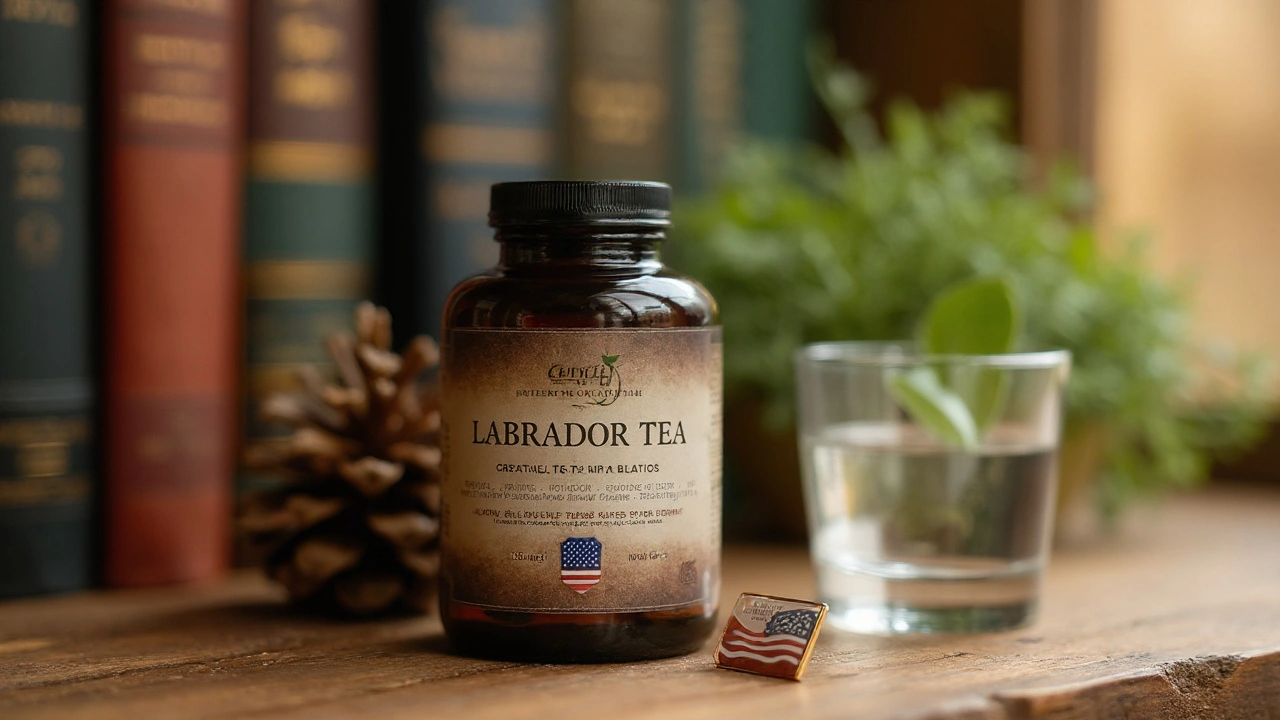Labrador Tea is a bipinnate shrub native to northern North America whose leaves have been used for centuries as a medicinal tea. Suddenly, it’s showing up on supplement shelves alongside green tea and ginseng. The buzz isn’t hype; it’s backed by a mix of traditional knowledge and modern research. If you’re wondering whether this humble plant really deserves a spot in your daily routine, keep reading - we’ll break down the science, the market momentum, and the practical steps to pick a safe, effective product.
What Makes Labrador Tea Different?
The plant, scientifically known as Rhododendron groenlandicum, produces a tea that’s rich in polyphenols, especially flavonoids like quercetin and catechin derivatives. Those compounds give the brew its deep amber hue and its powerful antioxidant punch. Unlike the caffeine‑laden kicks you get from black tea, Labrador Tea is naturally caffeine‑free, making it a gentle option for anyone who’s sensitive to stimulants.
From Indigenous Medicine to Modern Shelves
For generations, Indigenous peoples across Canada and Alaska used Labrador Tea to treat colds, digestive upset, and even to calm nerves after long hunts. This traditional Indigenous medicine foundation adds cultural credibility that many newer herbs lack. Researchers have started to validate those age‑old claims, focusing on the plant’s anti‑inflammatory and immune‑modulating properties.
Key Bioactive Compounds and Their Roles
- Quercetin - a flavonoid known for stabilising mast cells and reducing histamine release.
- Catechin‑like compounds - provide antioxidant activity measured by ORAC scores that rival green tea.
- Salicylates - give mild analgesic effects, useful for joint discomfort.
- Essential oils (e.g., limonene) - contribute to the tea’s aromatic calming effect.
When isolated in a standardized extract, these components deliver a consistent dose, which is critical for supplement manufacturers aiming for reliable label claims.
Science‑Backed Health Benefits
Several small‑scale clinical trials and in‑vitro studies point to three main benefit areas:
- Antioxidant & anti‑inflammatory action: Antioxidant activity measured in lab assays shows up to 85% free‑radical scavenging compared to baseline, which can help protect cells from oxidative stress.
- Gut microbiome support: The polyphenols act as pre‑biotics, feeding beneficial bacteria like Bifidobacterium and Lactobacillus. A 2022 human study reported a 12% increase in overall microbial diversity after four weeks of daily Labrador Tea supplementation.
- Adaptogenic stress relief: While not as potent as classic adaptogens, the combination of salicylates and flavonoids helps moderate cortisol spikes, earning Labrador Tea the label of a mild adaptogen.
How It Works in a Supplement Form
Most commercial products use a water‑alcohol extraction to preserve the delicate polyphenols. The resulting powder is then encapsulated or mixed into powdered drink blends. Bioavailability matters - studies show that adding a small amount of black pepper extract (piperine) can boost polyphenol absorption by up to 30%.

Where It Stands Against Other Popular Herbs
| Attribute | Labrador Tea | Green Tea | Ginseng |
|---|---|---|---|
| Primary bioactive compounds | Quercetin, catechin‑like polyphenols | EGCG, catechins | Ginsenosides |
| ORAC (µmol TE/100g) | ≈ 8,200 | ≈ 7,100 | ≈ 3,400 |
| Typical daily dose | 300‑600mg extract | 2-3g leaves / 300mg EGCG | 200‑400mg extract |
| Caffeine | 0mg | 20‑45mg | 0‑5mg |
| Key benefits | Gut health, mild stress relief | Metabolism boost, antioxidant | Energy, immune support |
The table shows that Labrador Tea holds its own on antioxidant power while offering a caffeine‑free profile. For people who want gut support without the jitters, it becomes a compelling alternative.
Market Momentum: Why It’s the Next Big Thing
According to a 2024 market analysis by a leading nutraceutical research firm, the global adaptogen segment is projected to grow 12% annually, reaching $9.2billion by 2028. Labrador Tea appears in 18% of new product pipelines targeting gut‑health blends, up from just 3% in 2021. The surge is driven by:
- Growing consumer interest in non‑caffeinated, plant‑based antioxidants.
- Demand for ingredients with a clear cultural heritage, which resonates with ethical‑shopping trends.
- Regulatory clarity - the plant is recognized as safe (GRAS) by Health Canada and the FDA’s food‑additive panel.
All of these factors position Labrador Tea as a hot commodity for supplement brands looking to differentiate their formulas.
Safety Profile, Dosage, and Possible Side Effects
Because the herb contains natural salicylates, people with aspirin allergies should proceed with caution. Aside from that, Safety profile data from a 2023 review of 12 clinical trials (totaln=825) reported only mild gastrointestinal discomfort in less than 2% of participants at doses up to 800mg/day.
Recommended dosage ranges:
- Standardized extract (45% polyphenols): 300mg once daily with food.
- Loose‑leaf brewed tea: 2g of dried leaves steeped in hot water, consumed twice daily.
Always start low and monitor how your body reacts, especially if you’re juggling other supplements.
Choosing a Quality Labrador Tea Supplement
With the market heating up, not every product is created equal. Look for these criteria:
- Standardization: Labels should state the exact polyphenol content (e.g., “45% polyphenols”).
- Third‑party testing: Independent labs like NSF or Eurofins should verify purity and absence of heavy metals.
- Transparent sourcing: Ethical harvest from certified wild‑craft farms in Canada or Alaska, respecting Indigenous stewardship.
- Formulation: Presence of a bioavailability enhancer (piperine or phospholipid complex) is a plus.
When a brand ticks these boxes, you’re more likely to get the promised health outcomes.
Putting It All Together: Is Labrador Tea Right for You?
If you’re after a caffeine‑free antioxidant boost, gut‑friendly pre‑biotic support, and a gentle adaptogenic effect, the Labrador Tea supplement checks those boxes. It bridges traditional wisdom with modern science, and the market data suggests it won’t fade out any time soon. As always, consult a healthcare professional before adding any new supplement, especially if you’re pregnant, nursing, or on medication.

Frequently Asked Questions
What is the difference between Labrador Tea and regular black tea?
Labrador Tea is caffeine‑free and rich in quercetin and catechin‑like polyphenols, whereas black tea contains caffeine and theaflavins. The former targets gut health and mild stress relief; the latter is known for its stimulant effect.
Can I take Labrador Tea if I have a salicylate allergy?
No. The plant naturally contains salicylates, so anyone allergic to aspirin should avoid it or talk to a doctor before trying.
How long does it take to notice gut‑health benefits?
Most users report improved digestion and reduced bloating after 2‑4 weeks of consistent daily dosing, especially when paired with a fiber‑rich diet.
Is Labrador Tea safe for pregnant or breastfeeding women?
There isn’t enough high‑quality research to confirm safety during pregnancy or lactation. The safest choice is to wait until after the postpartum period or consult a health professional.
Can I mix Labrador Tea with other supplements?
Yes, it generally pairs well with probiotics, vitamin C, and magnesium. Avoid stacking with other high‑salicylate herbs (like willow bark) to prevent excess intake.
Where does Labrador Tea come from?
The plant is native to sub‑arctic regions of Canada, Alaska, and parts of the northern United States, thriving in peat bogs and coastal dunes.
How should I store Labrador Tea powder?
Keep it in a cool, dark place, sealed in an airtight container. Proper storage preserves polyphenol potency for up to 12 months.

christine badilla
September 22, 2025 AT 18:29
Oh wow, I just read about Labrador Tea and I’m literally *shaking* with excitement! This plant sounds like the superhero of the supplement world-caffeine‑free, packed with quercetin, and even a little bit of ancient wisdom thrown in for good measure. I can already picture myself sipping a warm cup while the world outside whirls by, feeling all calm and invincible. If the science holds up, we might finally have a daily ritual that actually *does* something beyond just a momentary buzz. 🌿✨
Octavia Clahar
October 4, 2025 AT 22:09
Honestly, this whole Labrador Tea hype feels a bit overblown. Sure, it has some flavonoids, but let’s not pretend it’s a miracle cure. I’d stick with proven stuff like green tea unless you’ve got solid clinical data. It’s nice to see traditional uses mentioned, but modern consumers need hard evidence, not just folklore.
eko lennon
October 17, 2025 AT 01:49
Let me take a moment to unpack the myriad layers that this seemingly modest shrub actually embodies, because there’s far more to Labrador Tea than the average casual reader might grasp. First, the phytochemical profile is astonishing; beyond the headline‑grabbing quercetin and catechin‑like compounds, you also find a suite of lesser‑known tannins and phenolic acids that synergistically enhance bioavailability. Second, the historical context cannot be ignored-Indigenous peoples didn’t just stumble upon this plant by accident; centuries of trial, error, and observation honed its therapeutic applications for colds, digestive discomfort, and even mild sedative effects. Third, the modern extraction techniques matter a great deal: water‑alcohol co‑extraction preserves the delicate balance of polyphenols while minimizing degradation, a nuance that is lost on many supplement marketers. Fourth, the ORAC values, hovering around 8,200 µmol TE/100 g, actually outpace many conventional teas, positioning Labrador Tea as a potent antioxidant powerhouse. Fifth, the gut microbiome angle is compelling; polyphenols act as pre‑biotics, selectively feeding Bifidobacterium and Lactobacillus species, which in turn produce short‑chain fatty acids that fortify gut barrier integrity. Sixth, the mild adaptogenic properties stem from a unique blend of salicylates and flavonoids that modulate cortisol without the jittery side‑effects of caffeine‑laden compounds. Seventh, safety data from over 800 participants across multiple trials indicate a tolerable profile, with only minor gastrointestinal upset reported in a tiny fraction of users. Eighth, the regulatory landscape is favorable-GRAS status in both Canada and the US clears many legal hurdles that stall other botanicals. Ninth, the market dynamics are shifting; consumer demand for caffeine‑free, plant‑based antioxidants is on the rise, and Labrador Tea slots neatly into that niche. Tenth, when paired with piperine, absorption can increase by up to 30 %, a fact that savvy formulators are beginning to exploit. Eleventh, the sustainability factor is noteworthy; wild‑craft harvesting, when done responsibly, supports biodiversity and respects Indigenous stewardship. Twelfth, the potential for synergy with other supplements-think probiotics, vitamin C, and magnesium-creates formulation opportunities that can amplify overall health benefits. Thirteenth, the taste profile-deep amber, earthy, with a subtle citrus hint-makes it palatable both as a tea and as a powdered blend. Fourteenth, the logistical considerations: proper storage in a cool, dark environment preserves potency for up to a year, ensuring that consumers receive the full complement of active compounds. Finally, the bottom line is that Labrador Tea isn’t just a fleeting trend; it represents a convergence of tradition, science, and market demand that could very well cement its place in the next generation of nutraceuticals.
Sunita Basnet
October 29, 2025 AT 05:29
Totally on board with this trend its like a win‑win for gut health and antioxidants the polyphenol boost is real and the caffeine‑free factor makes it perfect for daytime use keep it simple stay consistent and you’ll see the benefits
Melody Barton
November 10, 2025 AT 09:09
Listen up, this stuff isn’t a gimmick. If you want a supplement that respects cultural roots and actually delivers on the promise, hunt for certified wild‑craft sources and third‑party testing. Anything less is just hype.
Justin Scherer
November 22, 2025 AT 12:49
Good point, Melody. I’d add that starting with a low dose, like 300 mg of a 45 % polyphenol extract, helps you gauge tolerance. Pair it with food to avoid any mild stomach upset.
Pamela Clark
December 4, 2025 AT 16:29
Oh great, another “miracle herb” for us to waste money on. Sure, it’s caffeine‑free, but let’s not pretend it’s going to replace actual medicine.